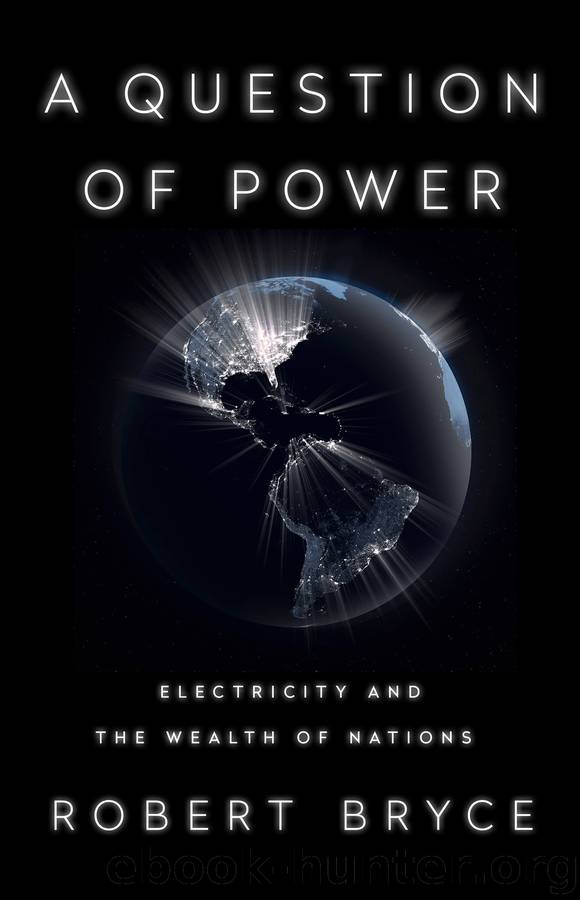A Question of Power by Robert Bryce

Author:Robert Bryce
Language: eng
Format: epub
Publisher: PublicAffairs
Published: 2020-03-09T16:00:00+00:00
California Electricity Prices Compared to US Average, 2011 to 2017
Source: Environmental Progress.
In addition, the lawsuit argues that California’s climate regulations are a regressive tax that is hitting poor and working-class consumers harder than their wealthier counterparts. Since 2007, the suit says, “California has had the highest poverty rate in the country,” with “over 8 million people living below the US Census Bureau poverty line when housing costs are taken into account.” It continues, claiming CARB has “ignored” the state’s “modest scale of greenhouse gas reductions, as well as the highly regressive costs imposed on current state residents by CARB’s climate programs.” The lawsuit focuses largely on the state’s housing and transportation policies, but it also says that California’s climate change policies increase “the cost of transportation fuels” and “further increase electricity costs.” Those high costs, it claims, “have caused and will cause unconstitutional and unlawful disparate impacts to California’s minority populations, which now comprise a plurality of the state’s population.”38
In September 2018, shortly after Governor Brown signed SB 100—a bill that requires the state to be obtaining at least 60 percent of its electricity from renewables by 2030—I interviewed John Gamboa, a member of the Two Hundred.39 Gamboa told me that California’s renewable energy policies are merely the latest example of how politicians ignore the poor and the middle class when making energy policy. “Every time they pass new regulations, the burden falls on the people who can least afford it,” he told me. “That’s the history of the environmental movement.”
James Bushnell, an economist at the University of California, Davis, found that renewable-energy policies are forcing up the state’s energy prices. In 2017, Bushnell published a short paper on the history of California’s electric grid, which he calls “a long and gory one.” Since the early 2000s, “the dominant policy driver” in California’s electricity sector, he writes, “has unquestionably been a focus on developing renewable sources of electricity generation.” Bushnell then explains that the renewable energy coming into the electricity market distorts prices because it favors wind and solar producers at the expense of traditional generators that rely on coal, natural gas, or nuclear. But because the electric grid still needs traditional generators to supply electricity when the sun isn’t shining and the wind isn’t blowing, the state’s utilities must continue operating (and paying for) traditional generation units. The result, Bushnell explains, is that the utilities pass the cost of maintaining all that traditional generation capacity onto end users. In addition, consumers have to pay for billions of dollars’ worth of new transmission lines needed to carry wind and solar electricity from remote regions into cities.40 Bushnell specifically mentions the $2 billion Tehachapi Renewable Transmission Project, which will carry electricity from renewable generators in Kern County south to San Bernardino County.41
Transmission spending by California has skyrocketed. In 2016 alone, the state’s utilities spent more than $20 billion on transmission projects. And, as Doug Karpa pointed out in a 2018 article for Utility Dive, between 2008 and 2018, spending on transmission projects in the state grew at an annual rate of more than 12 percent.
Download
This site does not store any files on its server. We only index and link to content provided by other sites. Please contact the content providers to delete copyright contents if any and email us, we'll remove relevant links or contents immediately.
The Secret History by Donna Tartt(16611)
The Social Justice Warrior Handbook by Lisa De Pasquale(11486)
Thirteen Reasons Why by Jay Asher(7783)
This Is How You Lose Her by Junot Diaz(5754)
Weapons of Math Destruction by Cathy O'Neil(5032)
Zero to One by Peter Thiel(4818)
The Myth of the Strong Leader by Archie Brown(4786)
Promise Me, Dad by Joe Biden(4441)
Stone's Rules by Roger Stone(4413)
Beartown by Fredrik Backman(4405)
How Democracies Die by Steven Levitsky & Daniel Ziblatt(4393)
The Fire Next Time by James Baldwin(4338)
100 Deadly Skills by Clint Emerson(4072)
A Higher Loyalty: Truth, Lies, and Leadership by James Comey(4027)
Rise and Kill First by Ronen Bergman(4009)
The David Icke Guide to the Global Conspiracy (and how to end it) by David Icke(3876)
The Farm by Tom Rob Smith(3870)
Secrecy World by Jake Bernstein(3774)
The Doomsday Machine by Daniel Ellsberg(3726)
